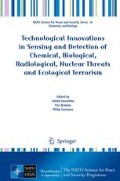Abstract
A new optical biosensor has been developed for detecting and quantifying aflatoxins that are commonly found in a variety of agricultural products. In the biosensor we use a high-tech semiconductor material – silicon for the efficient high-accuracy registration of narrow spectral bands or specific wavelengths. On its base, we develop a structure with two oppositely directed potential barriers. The total current conditioned by these barriers depends both on the external voltage and on the wavelength of the absorbed radiation. It is possible to modify these parameters and obtain high-accuracy data on mycotoxic contaminants in food and provender in natural conditions.
Access this chapter
Tax calculation will be finalised at checkout
Purchases are for personal use only
References
Haughey SA, Baxter GA, Jones CEN, O’Kennedy R, Stapleto S (2007) The detection of aflatoxins by optical biosensor analysis. XXV International congress of mycotoxins and phycotoxins, 25–27 May, Istanbul. Wageningen Academic Publishers, Wageningen, The Netherlands, p 430
Ngundi MM, Shriver-Lake LC, Moore MH, Lassman ME, Ligler FS, Taitt CR (2005) Array biosensor for detection of ochratoxin A in cereals and beverages. Anal Chem 77:148–154
Patel PD (2002) (Bio)sensors for measurement of analytes implicated in food safety. Trends Anal Chem 21:96–115
Zheng MZ, Richard JL, Binder J (2006) A review of rapid methods for the analysis of mycotoxins. Mycopathol 161:261–273
Schneider E, Curtui V, Seidler C, Dietrich R, Usleber E, Maertlbauer E (2004) Rapid methods for deoxynivalenol and other trichothecenes. Toxicol Lett 153:113–121
UK Silicon Photonics (2008) EPSRC Reference:EP/F001894/1
Khudaverdyan S, Dokholyan J, Arustamyan V, Khudaverdyan A, Clinciu D (2009) On the mechanism of spectral selective sensitivity of photonic biosensors. Nucl Instrum Meth A 610:314–316, ELSEVIER
European Commission. Food and Agriculture Organization EC/FAO (2004) Memorandum of anderstanding, concerning the establishment of strategic partnership between the food and agriculture organization of the United Nations and the commission of the European Communities in the field of development and humanitarian affairs
Khudaverdyan A (2009) About shot noise and speed of two barrier structures with thin base. Bull SEUA Ser Model Opt Contr 12(1):88–92
Author information
Authors and Affiliations
Corresponding author
Editor information
Editors and Affiliations
Rights and permissions
Copyright information
© 2012 Springer Science+Business Media B.V.
About this paper
Cite this paper
Khudaverdyan, S., Petrosyan, O., Dokholyan, J., Khudaverdyan, D., Tsaturyan, S. (2012). Modeling of a New Type of an Optoelectronic Biosensor for the Monitoring of the Environment and the Food Products. In: Vaseashta, A., Braman, E., Susmann, P. (eds) Technological Innovations in Sensing and Detection of Chemical, Biological, Radiological, Nuclear Threats and Ecological Terrorism. NATO Science for Peace and Security Series A: Chemistry and Biology. Springer, Dordrecht. https://doi.org/10.1007/978-94-007-2488-4_17
Download citation
DOI: https://doi.org/10.1007/978-94-007-2488-4_17
Published:
Publisher Name: Springer, Dordrecht
Print ISBN: 978-94-007-2487-7
Online ISBN: 978-94-007-2488-4
eBook Packages: Biomedical and Life SciencesBiomedical and Life Sciences (R0)

